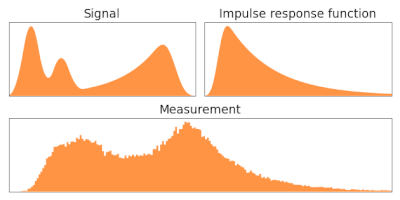The Richardson–Lucy algorithm, also known as Lucy–Richardson deconvolution, is an iterative procedure for recovering an underlying image that has been blurred by a known point spread function. It was named after William Richardson and Leon B. Lucy, who described it independently.[1][2]

Description
editWhen an image is produced using an optical system and detected using photographic film or a charge-coupled device, for example, it is inevitably blurred, with an ideal point source not appearing as a point but being spread out into what is known as the point spread function. Extended sources can be decomposed into the sum of many individual point sources, thus the observed image can be represented in terms of a transition matrix p operating on an underlying image:
where is the intensity of the underlying image at pixel and is the detected intensity at pixel . In general, a matrix whose elements are describes the portion of light from source pixel j that is detected in pixel i. In most good optical systems (or in general, linear systems that are described as shift invariant) the transfer function p can be expressed simply in terms of the spatial offset between the source pixel j and the observation pixel i:
where is called a point spread function. In that case the above equation becomes a convolution. This has been written for one spatial dimension, but most imaging systems are two dimensional, with the source, detected image, and point spread function all having two indices. So a two dimensional detected image is a convolution of the underlying image with a two dimensional point spread function plus added detection noise.
In order to estimate given the observed and a known , the following iterative procedure is employed in which the estimate of (called ) for iteration number t is updated as follows:
where
and is assumed. It has been shown empirically that if this iteration converges, it converges to the maximum likelihood solution for .[3]
Writing this more generally for two (or more) dimensions in terms of convolution with a point spread function P:
where the division and multiplication are element wise, indicates a 2D convolution, and is the flipped point spread function.
In problems where the point spread function is not known a priori, a modification of the Richardson–Lucy algorithm has been proposed, in order to accomplish blind deconvolution.[4]
Software
edit- RawTherapee (since v.2.3)
See also
editReferences
edit- ^ Richardson, William Hadley (1972). "Bayesian-Based Iterative Method of Image Restoration". Journal of the Optical Society of America. 62 (1): 55–59. Bibcode:1972JOSA...62...55R. doi:10.1364/JOSA.62.000055.
- ^ Lucy, L. B. (1974). "An iterative technique for the rectification of observed distributions". Astronomical Journal. 79 (6): 745–754. Bibcode:1974AJ.....79..745L. doi:10.1086/111605.
- ^ Shepp, L. A.; Vardi, Y. (1982), "Maximum Likelihood Reconstruction for Emission Tomography", IEEE Transactions on Medical Imaging, 1 (2): 113–22, doi:10.1109/TMI.1982.4307558, PMID 18238264
- ^ Fish D. A.; Brinicombe A. M.; Pike E. R.; Walker J. G. (1995), "Blind deconvolution by means of the Richardson–Lucy algorithm" (PDF), Journal of the Optical Society of America A, 12 (1): 58–65, Bibcode:1995JOSAA..12...58F, doi:10.1364/JOSAA.12.000058, S2CID 42733042, archived from the original (PDF) on 2019-01-10